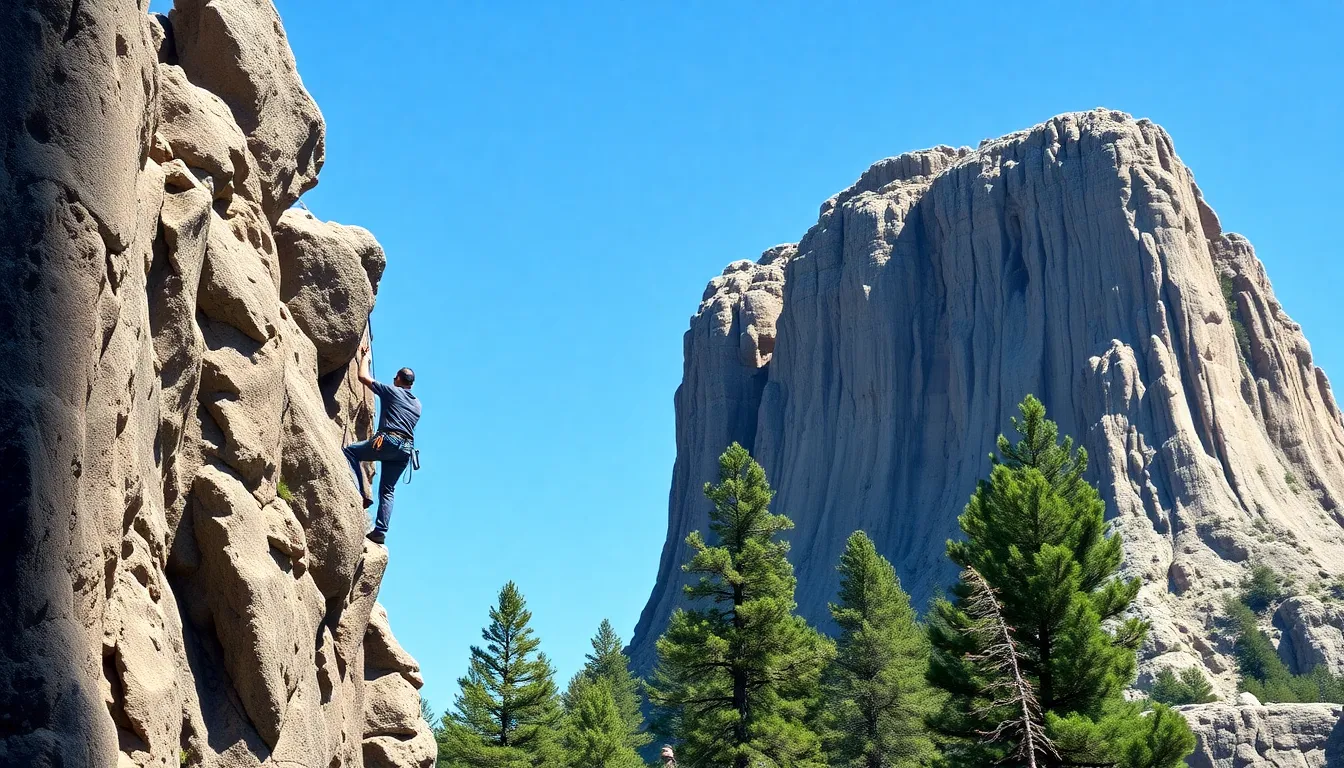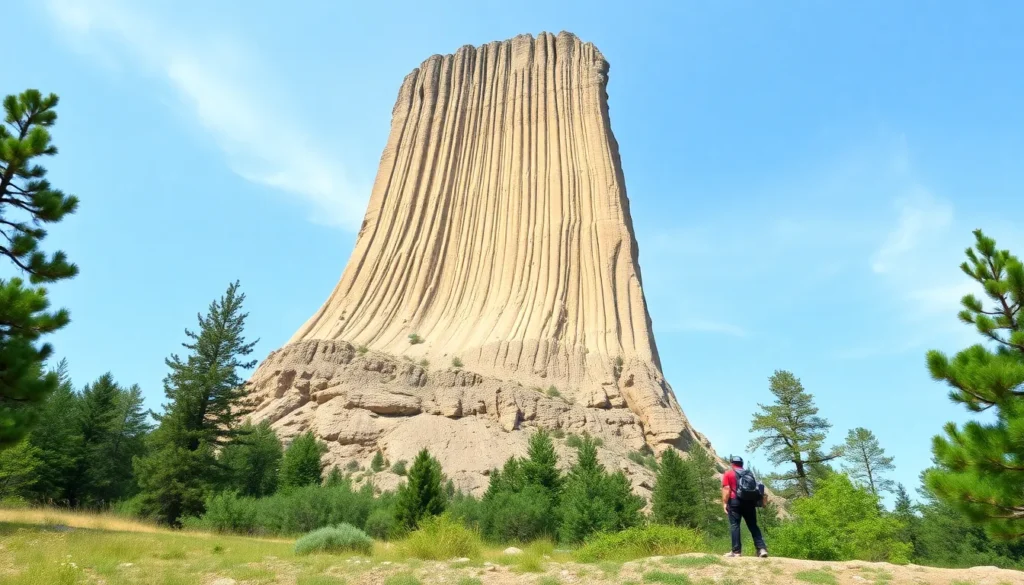Table of Contents
ToggleDevils Tower, a majestic monolith rising from the Wyoming plains, draws rock climbers from all corners of the globe. Known for its stunning views and challenging routes, it’s a paradise for adventure seekers. But lurking beneath its beauty is a sobering reality—climbing this iconic formation can be perilous.
Tragedy has struck on these rugged cliffs, leaving a trail of heart-wrenching stories and cautionary tales. Each year, climbers push their limits, and while many succeed, the risks are real. Understanding the dangers associated with climbing at Devils Tower is crucial for anyone dreaming of conquering its heights. So grab your chalk bag and helmet, but remember—safety first, or you might end up as the punchline in a very grim joke.
Overview of Devils Tower
Devils Tower stands as a prominent geological formation in northeastern Wyoming, reaching an elevation of 5,112 feet. The site encompasses roughly 1,347 acres and became the United States’ first national monument in 1906. Visitors admire its striking vertical columns formed from cooling magma and erosion. These distinct features attract rock climbers and outdoor enthusiasts seeking both challenge and beauty.
Numerous climbing routes vary in difficulty, appealing to different skill levels. Experienced climbers often tackle the more demanding routes while beginners can find accessible paths. The area also offers hikes and scenic viewpoints, providing breathtaking panoramas of the surrounding landscape.
Seasonal weather plays a significant role in climbing conditions. Spring and fall offer ideal temperatures for climbs, while summer can bring thunderstorms. Understanding these environmental factors greatly aids climbers in planning their excursions.
Wildlife thrives in the region, with species such as deer, elk, and numerous birds frequently spotted. Sightings enhance the overall experience of visiting the monument and emphasize the site’s ecological importance.
A cultural significance enriches the site, with Native American tribes considering it sacred. They participate in traditional rituals, highlighting its spiritual relevance alongside its recreational opportunities. Awareness of this aspect fosters respect among climbers and visitors.
Safety considerations remain paramount. Each climber should assess their skill level and the route’s challenges seriously. Additionally, awareness of the area’s climbing regulations, potential hazards, and wildlife ensures a safer experience.
Devils Tower captivates a diverse audience, combining adventure and respect for nature. Every climber experiences unique challenges here, making it a memorable destination for outdoor enthusiasts.
The Significance of Rock Climbing at Devils Tower

Rock climbing at Devils Tower holds immense significance for climbers seeking adventure and natural beauty. This iconic landmark blends challenging routes with a rich cultural history.
Historical Context
Devils Tower became the first national monument in the United States in 1906. The formation’s geological history spans millions of years, with its striking columns resulting from ancient volcanic activity. Native American tribes also regard the tower as sacred, incorporating it into their cultural narratives and spiritual practices. The site’s designation as a national monument reflects efforts to protect its unique features and historical value. Climbing traces back to the early 20th century, with some of the first ascents documented in the 1930s. The deep appreciation for both nature and history contributes to the significance of climbing in this majestic area.
Popular Climbing Routes
Routes at Devils Tower cater to various experience levels, attracting climbers from around the world. The Durrance Route remains the most popular, providing a moderate climb for those with basic technical skills. The Arrowhead Arete offers a more challenging option, featuring mixed climbing techniques and requiring advanced skills. The Beehive attracts adventurous climbers with its steep, exhilarating ascent. Many routes include crack climbing, fundamental to skill development. Seasonal conditions heavily influence climbing experiences, often making spring and fall the most favorable times. Adventure enthusiasts consistently seek out these routes for both the thrill of climbing and the stunning views offered at the summit.
Recent Incidents of Rock Climber Death at Devils Tower
Tragic incidents have occurred at Devils Tower, raising awareness about the inherent risks of rock climbing. In recent years, fatalities have been reported, involving both experienced climbers and novices. Each case highlights the importance of safety protocols while navigating this challenging landscape.
Case Study: Specific Incidents
In June 2021, a climber fell approximately 200 feet while attempting the Durrance Route, resulting in a fatal injury. Another incident in August 2018 claimed the life of an experienced climber who became disoriented due to sudden weather changes. These occurrences serve as stark reminders of the vulnerabilities climbers face, urging them to take precautions seriously.
Analysis of Contributing Factors
Several factors contribute to climbing accidents at Devils Tower. Weather changes often create hazardous conditions, especially during unpredictable summer storms. Skill level plays a crucial role; inexperienced climbers may underestimate the difficulty of routes. Additionally, the vertical rock face demands precise technique and focus, with even minor missteps leading to severe consequences. Awareness of these issues can enhance climbers’ safety and inform their decision-making.
Safety Precautions for Climbers
Climbers must prioritize safety to enjoy the experience at Devils Tower. Understanding specific precautions can minimize risks and enhance climbing experiences.
Best Practices for Climbing
Assess skill levels before attempting climbs. Beginners should choose routes that match their experience. Staying informed about weather conditions helps identify potential dangers. Establish communication with climbing partners to ensure everyone stays aware of the plan. Regularly take breaks to remain alert and focused during climbs. Pay attention to the climbing environment, including the surface and rock quality, to avoid potential hazards. Monitor fatigue levels since climbing demands physical endurance. It’s crucial to follow park regulations and guidelines for a safe adventure.
Equipment Recommendations
Select appropriate gear to enhance safety while climbing. Harnesses must fit securely and provide proper support. Use climbing shoes for maximum grip and traction on the rock face. Chalk bags help maintain dry hands, improving grip. Carry a helmet to protect against falling debris and potential impacts. Identify the right climbing ropes based on the chosen route and climbing style. A well-stocked first aid kit addresses minor injuries during climbs. Cams and nuts add protection when navigating challenging sections. Ensure all equipment is regularly inspected and maintained, promoting equipment reliability.
Community Response to Climber Deaths
Recent climber fatalities at Devils Tower have prompted significant reflection and dialogue within the climbing community. These incidents, including the tragic 200-foot fall in June 2021, have raised serious concerns about safety practices and risk awareness among climbers.
Impact on the Climbing Community
Climber fatalities have brought the importance of safety to the forefront of conversations among climbers and outdoor organizations. Many climbers express heightened awareness regarding the environmental conditions that can influence climbing safety. Additionally, discussions surrounding best practices for equipment use have gained traction. Peer support networks are stronger, emphasizing shared responsibility among climbers. These responses contribute to a culture prioritizing safety alongside adventure, showcasing a commitment to preserving life while navigating the thrills of climbing.
Changes in Regulations or Guidelines
In response to climbing accidents, certain regulations and guidelines are evolving. The National Park Service is revisiting safety protocols, enhancing educational programs for climbers about environmental risks and necessary precautions. Furthermore, they encourage climbers to assess their own skill levels realistically. New signage and informational resources are appearing at climbing areas, aiming to inform about specific dangers tied to weather changes and climbing techniques. These changes reflect a proactive approach to minimize risks, ensuring the safety of climbers at this iconic site.
Conclusion
Devils Tower remains a breathtaking destination for climbers and nature lovers alike. Its unique geological features and rich cultural significance draw many to its towering heights. However the recent tragedies serve as a stark reminder of the inherent risks involved in rock climbing.
Climbers must prioritize safety by understanding their limits and staying informed about changing weather conditions. The climbing community’s ongoing dialogue about safety practices reflects a commitment to preserving the thrill of the climb while minimizing risks.
As climbers venture to this iconic monument they should carry with them a respect for the natural environment and the history it represents. With the right precautions and awareness climbers can safely enjoy the adventure that Devils Tower offers.







